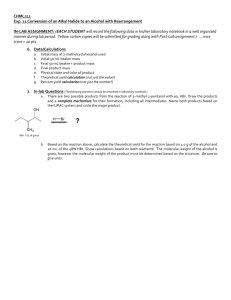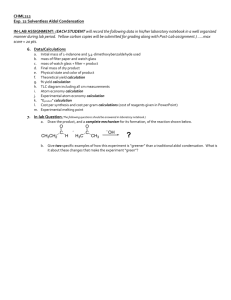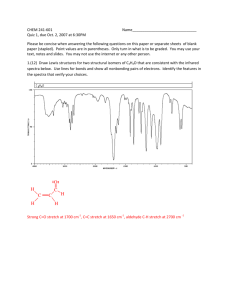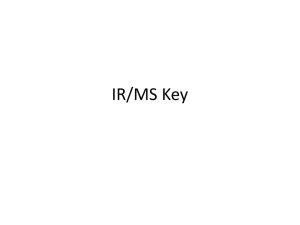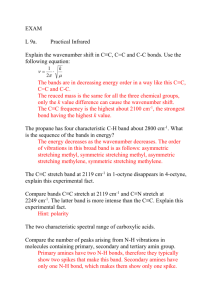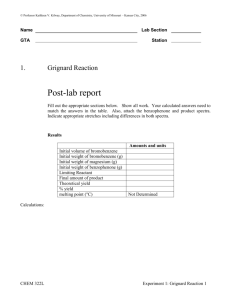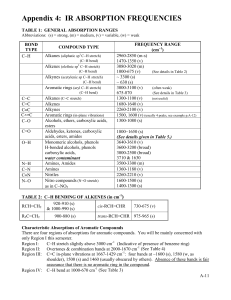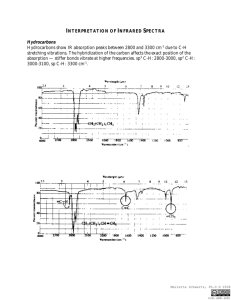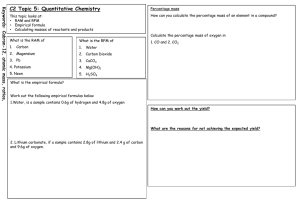Experiment 10 IN/POST LAB assignment
advertisement
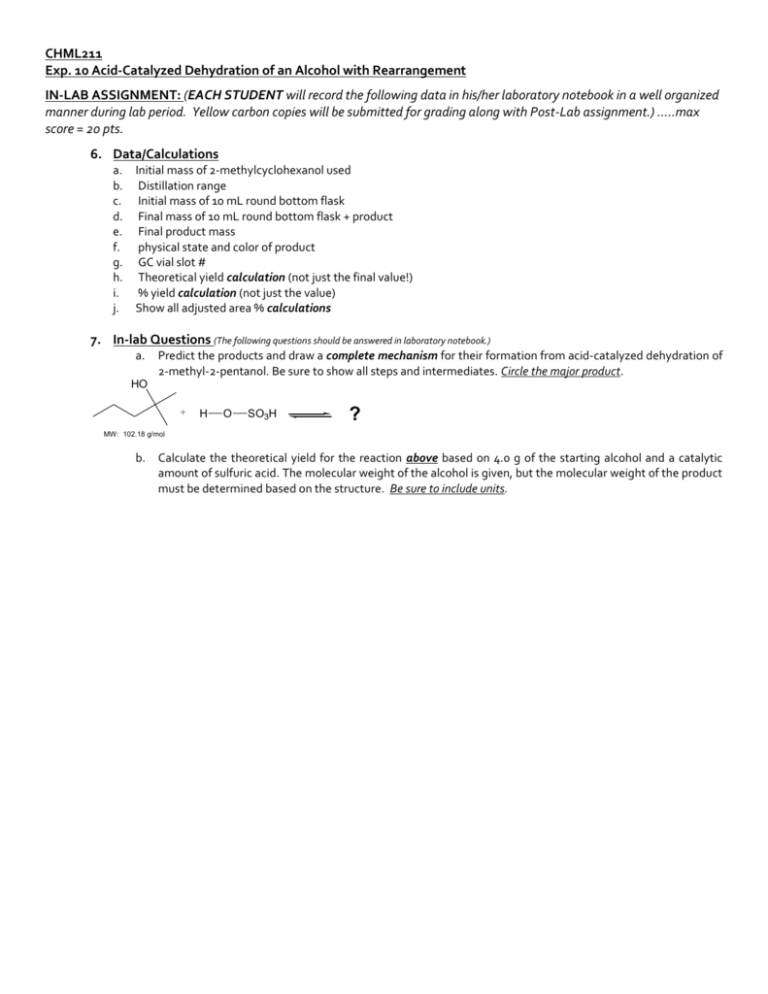
CHML211 Exp. 10 Acid-Catalyzed Dehydration of an Alcohol with Rearrangement IN-LAB ASSIGNMENT: (EACH STUDENT will record the following data in his/her laboratory notebook in a well organized manner during lab period. Yellow carbon copies will be submitted for grading along with Post-Lab assignment.) …..max score = 20 pts. 6. Data/Calculations a. b. c. d. e. f. g. h. i. j. Initial mass of 2-methylcyclohexanol used Distillation range Initial mass of 10 mL round bottom flask Final mass of 10 mL round bottom flask + product Final product mass physical state and color of product GC vial slot # Theoretical yield calculation (not just the final value!) % yield calculation (not just the value) Show all adjusted area % calculations 7. In-lab Questions (The following questions should be answered in laboratory notebook.) a. Predict the products and draw a complete mechanism for their formation from acid-catalyzed dehydration of 2-methyl-2-pentanol. Be sure to show all steps and intermediates. Circle the major product. HO + H O SO3H ? MW: 102.18 g/mol b. Calculate the theoretical yield for the reaction above based on 4.0 g of the starting alcohol and a catalytic amount of sulfuric acid. The molecular weight of the alcohol is given, but the molecular weight of the product must be determined based on the structure. Be sure to include units. CHML211 Exp. 10 Acid-Catalyzed Dehydration of an Alcohol with Rearrangement POST-LAB ASSIGNMENT: (EACH LAB GROUP will submit one copy of a typewritten, paragraph style report addressing all of the points listed below. Must be written using PAST TENSE, PASSIVE VOICE. ) …..max score = 50 pts. 8. Experimental (Write 1-2 paragraphs including all of the following. Do NOT present a bulleted outline.) What type of reaction was performed? Describe the actual synthetic procedure. Include names of any reactants used and desired product, as well as name of solvent and catalyst used (if any). Be sure to give actual volumes/masses of compounds used during the synthesis (not just what the lab manual tells you to use). Describe the purification technique used to isolate the desired product. Be sure to give names and actual volumes/masses of any compounds used during the purification process. Describe the analytical technique (GC) used to evaluate the product, including preparation of GC sample, name and actual volume of GC solvent used, and how compounds were identified using this technique. Include use of any spectral analysis. 9. Results (Complete tables. Once complete, copy/paste completed tables into your document.) Table 10.1 Experimental results Compound Final Mass of product (g) Theoretical Yield (g) Percent Yield Product Appearance Table 10.2 GC analysis results GC Retention time (min) Area Percent Standard Sample Adjusted Area Percent methanol 2-methylcyclohexanol 1-methyl-1-cyclohexene 3-methyl-1-cyclohexene methylenecyclohexane Functional Group Base Values (cm-1) OH stretch C-O stretch sp3 CH stretch sp2 CH stretch C=C stretch 3200-3400 1000-1200 2850-3000 3000-3100 1600-1680 Table 10.3 IR spectral analysis results 2-methyl1-methyl-13-methyl-1cyclohexanol cyclohexene cyclohexene Frequency (cm-1) Frequency (cm-1) Frequency (cm-1) methylenecyclohexane Frequency (cm-1) 10. Discussion (Write 1-2 pages, addressing all of the following points.) Restate the name of the reactants combined and the name of the product formed during the synthesis. State the final product mass and the calculated percent yield for the synthesis. Be sure to report these values using the correct units. Based on the GC results, were the reactants completely converted to the desired product? Explain this conclusion by stating the GC retention times of each compound in the standard provided, along with the GC retention times and adjusted area percent of any compound which appears in the sample chromatogram. How can IR spectroscopy be used to differentiate between the reactant alcohol and the MAJOR product alkene in this experiment? Give the identity of one type of absorption and how it could be used to determine whether or not the conversion took place. Include the typical frequency and the actual frequency for this type of bond in your statement. Be sure to include units for frequencies. Include a short comment addressing what could be done differently to improve the experimental results if repeated. Be sure to attach GC chromatogram!
